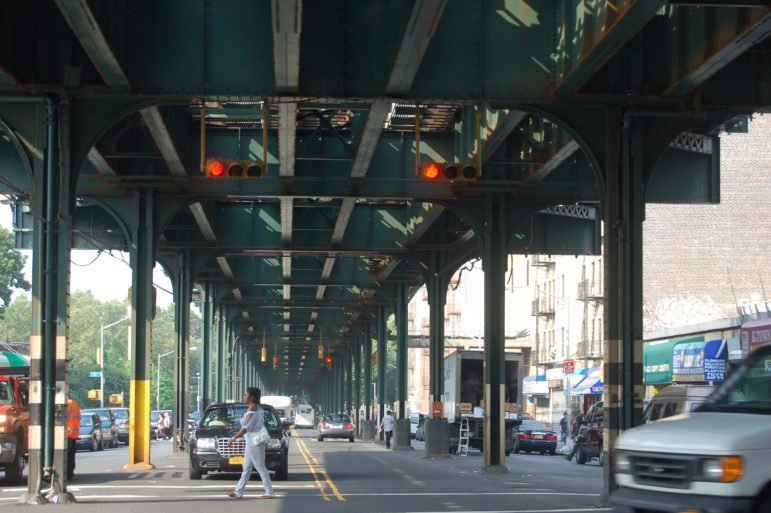
Daniel C
Under the 4 train along Jerome Avenue.
The ULURP clock is ticking. Bronx Community Boards 4 and 5 will vote on the Jerome Avenue rezoning next week—the first stage in a multi-step review process through which a rezoning is approved or disproved. Yet at a Land Use Committee meeting on October 10, Board 4 members expressed frustration with what they said was a lack of sufficient information about the community benefits associated with the plans, the potential affordability of the new housing, and especially, the lack of a guarantee for a new school.
“I understand that the landlords will gain in revenue and I understand that the city and the boroughs will collect more taxes, but those of us who are here are going to be in even more [of] the ‘coach seating’ of life,” said Parks Committee Chair John Howard Algarin that evening. “It seems like the seats are getting more and more narrow with less and less leg room and they’re trying to convince us that they’re doing us a favor somehow.”
Such sentiments—about a lack of sufficient information—are common to the neighborhood rezoning process. Granted, the city has already published a long list of investments, it is making in the Jerome Avenue area as well as strategies it will use to fight displacement, has committed to exploring the possibility of a new school, and has said it’s in conversation with nonprofit developers who are interested in working with the city to build affordable housing. Yet Board 4 members continue to express concerns about a lack of details.
The Bronx Coalition for a Community Vision has pointed to the uncertainties as a reason to stop the rezoning. Its members argue that the affordable housing that would be required under the city’s mandatory inclusionary housing policy is too little—and too unaffordable—to be of significance, and they’re unwilling to trust the city’s hypothesis that, because of the weak market, most of the housing built in the areas will be affordable, with developers voluntarily turning to the city for subsidies. They further argue that the city’s existing subsidy programs don’t go far enough to help the poorest families, and they say there’s no definite proof that the city’s anti-displacement strategies will succeed in keeping people in their homes if the rezoning exacerbates rent pressures.
Even if you take the city at its word about how spurring the private market through a rezoning will increase affordability and improve the neighborhood, there do seem to be a couple missing details about the proposal as compared to other rezoning neighborhoods. In East New York, more than four months prior to the community board’s vote on the rezoning, the Brooklyn City Planning office had already announced a new school and 1,200 units of guaranteed affordable housing on a combination of public land and on private land owned by a non-profit developer. In East Harlem, a housing plan was released more than a month before the community board vote that explained where the city intended to invest housing subsidies (though in both those neighborhoods, residents still felt that was insufficient information).
At the October 10 Land Use Committee meeting, Bronx Community Board 4 board members tried to brainstorm possible public or private parcels of land in the area that could be turned into a new school. Throughout the rezoning process, the city has repeatedly conveyed that in the Jerome Avenue area there is little public land that can redeveloped. Only on public land can the government control the type of development that occurs and, in the case of housing, the exact levels of affordability. City Limits used the Living Lots NYC map to find vacant, public land that could provide opportunities for development in roughly a quarter-mile radius of the Jerome Avenue rezoning area. We found four vacant sites that the city already intends to develop with below-market housing, and two more where it looked like development might be possible.
After inquiries from City Limits, HPD said it is still exploring whether there are any opportunities to redevelop public land in the area, but that most opportunities for creating additional affordable housing will come from subsidizing developers on privately owned land.
In addition, HPD said City Planning still intends on releasing a “neighborhood plan” for Jerome Avenue that goes into additional detail about its strategies for Jerome, including on housing. Yet unless that plan comes out by next Tuesday—when Community Board 4 must vote—the boards will take their vote without knowing those details.
At the end of the day, while the de Blasio administration has clearly stepped up community engagement from prior administrations, the situation in Jerome exposes an ongoing issue: Is it really community planning if community boards must take crucial steps with partial information?







